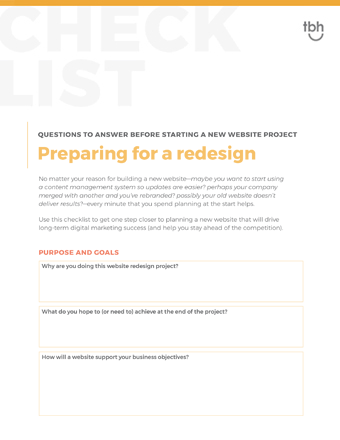
Managing a website project is a big undertaking.
With all the pieces to consider, one important process to nail down is how your team will handle reviews and approvals throughout the project. Without a plan, there can be hold-ups and delays, miscommunications, and other inefficiencies that can add up to be costly.
At the beginning of the project, consider the following:
With all the pieces to consider, one important process to nail down is how your team will handle reviews and approvals throughout the project. Without a plan, there can be hold-ups and delays, miscommunications, and other inefficiencies that can add up to be costly.
At the beginning of the project, consider the following:
- Who needs to approve each milestone?
- Which opportunities to take decisions to leadership instead of questions?
- How can you avoid common pitfalls that can derail a project?
Consider project milestones
1. Choosing a web design agency
Decision maker: Senior-level manager or leadership team memberOften, a member of the marketing team will do the initial legwork and narrow in on a couple of top choices. Then, to get approval, a senior-level manager or leadership team member will make the final sign-off in regards to project direction, scope, and budget.
2. Design preferences (likes vs. dislikes)
Decision maker: Project owner, with select input from other team membersMarketing team or project owners—following existing visual brand guidelines—make most design recommendations, but sometimes it’s crucial to include specific input from others.
For example, if your company owner has specific preferences about the brand or representation, it is a good idea for the marketing team to get notes from the owner at the start of the project.
3. Website content organization
Decision maker: Project ownerTypically, the marketing team will handle the discussion points and give direction/input on the new site architecture recommendations. If there are specific sticking points, the marketing team may get approval from senior leadership to avoid re-work down the line.

Download the Website Planning Checklist. Use this tool to start planning a new website that will drive long-term digital marketing success.
Download now
Download now
4. Company information sources
Decision maker: Project ownerProject leaders help to fill in the blanks as much as possible, and loop in internal subject matter experts as needed for content writing. This ensures that your content is accurate and represents your company well.
5. Wireframe approval
Decision maker: Project ownerA wireframe is a sketch of the new website design. It will include elements on the page for layout and priority, as well as a first draft of how navigation and the footer will look on the new website. If you’re working directly with the web design agency throughout this stage, it is often unnecessary to get all hands on deck to approve wireframes.
6. High-fidelity design approval
Decision maker: Senior levelOn the other hand, high-fidelity designs bring the new website design to life with images, approved content, colors, fonts, and logos. The next step after high-fidelity is to code the website, so it is necessary for any decision-makers to weigh-in at this stage and give approval.
7. Development (website coding)
Decision maker: Project ownerYou may not be as involved in the development stage, but there are often little items that trickle in as the code is developed. The website design agency may ask if you prefer full-width photos, scrolling elements, spacing, and other formatting decisions as the website is being developed. These are often quick decision points that don’t require a lot of internal debate or red tape.
Prepare rationale for recommendations
It’s all about the rationale. Several micro-decisions may not even be recognized to the general observer, but occasionally specific likes or dislikes will crop up late in a project. Be prepared to talk through why you chose what you did.Back it up with evidence
If you’ve created the new site design and content with the user in mind, you can site persona research or general best practices explaining why the website needs fewer navigation options or explain that the big video files can slow down performance, which can turn users off to your content.Pick your battles
Inevitably, some decisions in a website project are subjective. Too often we see a website project get hung up on a small decision where team members won’t budge. Consider your goals and your users, and determine if the fight is worth it.Example scenario
Your company’s owner wants the testimonials panel on your site’s homepage to change to a rotator instead of a static quote? Consider how to adjust the design or make a compromise to keep the project moving. Respond to the feedback with a statement, like:
I’ll add this to our phase two list. Since this change isn’t critical to complete before we launch, let’s keep the project moving while we work on addressing this recommendation.
Avoid common pitfalls in a website project
Unrealistic timelines
While a web design agency has worked on lots of website projects and can accurately predict their timing needed for project steps, most companies who hire agencies aren’t so sure about timing needed on their end. Clients often over-commit to review timelines and then miss the deadline, when it is much more efficient for everyone’s time when you can be realistic about the time you’ll need for review.The more people involved in the review/approval, the more time it will generally take.Talking through and compiling feedback from busy team members takes some doing, and that’s okay. Just be sure to communicate along the way so that your website design agency is in the loop and can plan accordingly.
Making changes to completed work
Once work has been reviewed and approved, it can throw off the project to go back and re-work it. Depending on the stage in the project, this may result in extra billable hours or pushing back the launch timeline. Reiterating the need to be realistic about the timing your team will need to review and approve work throughout the project.Delaying presentation meetings
When bigger teams need to coordinate calendars, this often means looking at meeting dates that are further out, sometimes more than two weeks in advance. One strategy that has worked well is to plan smaller meetings with core project members who can then take the notes back to a bigger group to compile feedback. This cuts down on subjective opinions and feedback at each step of the project. Instead, project owners can present the rationale and specific discussion points to get the most important feedback from the whole group.There is no cookie-cutter approach to managing a website project, but there are steps you can take with your team to establish your review and approval process for a successful project.
Ready to revamp your website? Start here
You might also like:
